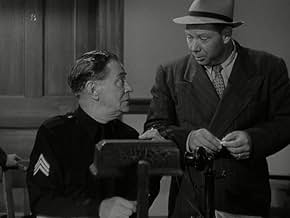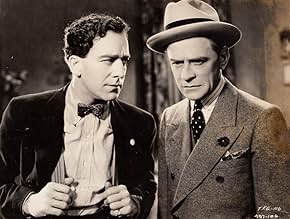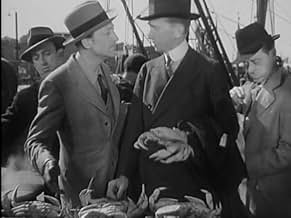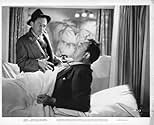Thomas E. Jackson(1886-1967)
- Actor
Thomas Edward Jackson (1886-1967) began his acting career with juvenile parts on Broadway from 1899-1903. As a tough kid living in New York's lower east side, Jackson would become a boxer and serve in WW1. He returned to the theatre in 1917 and worked steadily through the end of 1928.
Jackson would gain notoriety on stage for his tough sarcastic detective Dan McCorn in George Abbott's 1926 hit show entitled "Broadway". After this success, he became a producer and director for a couple of Broadway flops. But as luck would have it, the advent of talking pictures meant that his skills would be in demand in Hollywood. The 43-year old actor was enticed to the west coast to recreate role for Paul Fejos' Universal Pictures filmed adaptation of "Broadway" (1929). This film was notable for employing complex crane and dolly camera movements, not seen in any other early sound films at the time. In fact, this ambitious visual style wouldn't be seen until Citizen Kane over a decade later. "Broadway" was nearly forgotten by history. Among film historians, this was "a lost film" for nearly a century before being restored from a few surviving prints recently found around the world. This restoration appeared as an extra for a Blu Ray release of Paul Fejos' "Lonesome" in 2012. The version of "Broadway" that exists today from this release remains incomplete, in need of further restoration.
After "Broadway", Jackson drew on his Dan McCorn character for a variety of films, most notably as Sgt. Tom Flaherty in "Little Caesar" (1931). His distinctive detective characters continued for nearly two decades, most notably as the witty Inspector Jackson in Fritz Lang's definitive noir film "The Woman in the Window" (1944).
He often appeared as a newspaper editor, reporter, policemen, politicians, and a wide variety of other characters.
During his 37 year career in Hollywood, he appeared in over 300 film, radio and television works. For some time in the 30's he was under contract with Warner Brothers. During this time he acted in scenes opposite Edward G. Robinson (3 times), William Powell (3 times), Clark Gable (twice), Humphrey Bogart (twice), and James Cagney.
Jackson worked for legendary directors Mervyn LeRoy, Micheal Curtiz, William Wyler, Fritz Lang, Douglas Sirk, and even Roger Corman. Often he worked with these directors two times or more.
For the first time in over 50 years, Jackson was seen in a newly discovered pre-release version of the the Bogart/Bacall classic "The Big Sleep" (1945) in densely plot driven scene as District Attorney Wilde. This is notable because the exclusion of this scene made "The Big Sleep" a famously confusing movie. The film's director Howard Hawkes had said that even he didn't know who the murderer was.
Also notable:
-Jackson was the first on screen character the Three Stooges referred to as 'wise guy' in "Myrt and Marge" (1933) as slimy producer Johnny Jackson. "Myrt and Marge" is also the 'picture show' the main characters watch in the Coen Brother's film O Brother Where Art Thou? (2000).
-His character 'Snow' in Manhattan Melodrama has an interesting historical significance for true crime buffs. As the film played at Chicago's Biograph theatre on the evening of July 22nd 1934, notorious gangster John Dillinger was in attendance. In a pivotal scene, Dillinger watched as Jackson's Snow was shot and killed by Clark Gable's gangster character. Moments after the film, Dillinger was fatally gunned down outside the theatre, as depicted in in the Michael Mann film "Public Enemies" (2009).
Jackson would gain notoriety on stage for his tough sarcastic detective Dan McCorn in George Abbott's 1926 hit show entitled "Broadway". After this success, he became a producer and director for a couple of Broadway flops. But as luck would have it, the advent of talking pictures meant that his skills would be in demand in Hollywood. The 43-year old actor was enticed to the west coast to recreate role for Paul Fejos' Universal Pictures filmed adaptation of "Broadway" (1929). This film was notable for employing complex crane and dolly camera movements, not seen in any other early sound films at the time. In fact, this ambitious visual style wouldn't be seen until Citizen Kane over a decade later. "Broadway" was nearly forgotten by history. Among film historians, this was "a lost film" for nearly a century before being restored from a few surviving prints recently found around the world. This restoration appeared as an extra for a Blu Ray release of Paul Fejos' "Lonesome" in 2012. The version of "Broadway" that exists today from this release remains incomplete, in need of further restoration.
After "Broadway", Jackson drew on his Dan McCorn character for a variety of films, most notably as Sgt. Tom Flaherty in "Little Caesar" (1931). His distinctive detective characters continued for nearly two decades, most notably as the witty Inspector Jackson in Fritz Lang's definitive noir film "The Woman in the Window" (1944).
He often appeared as a newspaper editor, reporter, policemen, politicians, and a wide variety of other characters.
During his 37 year career in Hollywood, he appeared in over 300 film, radio and television works. For some time in the 30's he was under contract with Warner Brothers. During this time he acted in scenes opposite Edward G. Robinson (3 times), William Powell (3 times), Clark Gable (twice), Humphrey Bogart (twice), and James Cagney.
Jackson worked for legendary directors Mervyn LeRoy, Micheal Curtiz, William Wyler, Fritz Lang, Douglas Sirk, and even Roger Corman. Often he worked with these directors two times or more.
For the first time in over 50 years, Jackson was seen in a newly discovered pre-release version of the the Bogart/Bacall classic "The Big Sleep" (1945) in densely plot driven scene as District Attorney Wilde. This is notable because the exclusion of this scene made "The Big Sleep" a famously confusing movie. The film's director Howard Hawkes had said that even he didn't know who the murderer was.
Also notable:
-Jackson was the first on screen character the Three Stooges referred to as 'wise guy' in "Myrt and Marge" (1933) as slimy producer Johnny Jackson. "Myrt and Marge" is also the 'picture show' the main characters watch in the Coen Brother's film O Brother Where Art Thou? (2000).
-His character 'Snow' in Manhattan Melodrama has an interesting historical significance for true crime buffs. As the film played at Chicago's Biograph theatre on the evening of July 22nd 1934, notorious gangster John Dillinger was in attendance. In a pivotal scene, Dillinger watched as Jackson's Snow was shot and killed by Clark Gable's gangster character. Moments after the film, Dillinger was fatally gunned down outside the theatre, as depicted in in the Michael Mann film "Public Enemies" (2009).


























